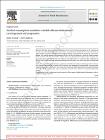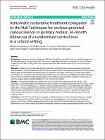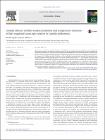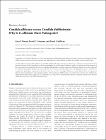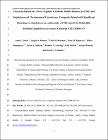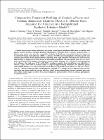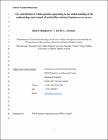Browsing Dental Science (Scholarly Publications) by Title
Now showing items 1-20 of 134
-
AIR AND SURFACE CONTAMINATION PATTERNS OF METHICILLIN-RESISTANT Staphylococcus aureus ON EIGHT ACUTE HOSPITAL WARDS
(2014)BACKGROUND. Methicillin-resistant Staphylococcus aureus (MRSA) can be recovered from hospital air and from environmental surfaces. This poses a potential risk of transmission to patients. OBJECTIVE. To investigate ... -
Alcohol consumption modulates Candida albicans-induced oral carcinogenesis and progression
(2023)Objectives: This study aimed to determine the impact of low levels of alcohol consumption on the interaction of the oral cavity with Candida albicans, a species that is commonly found at higher levels in the oral cavities ... -
Applied Research Methods in Maxillofacial Prosthetics
(IADR Irish Division, 2017) -
Atraumatic restorative treatment compared to the Hall Technique for occluso-proximal carious lesions in primary molars; 36-month follow-up of a randomised control trial in a school setting
(2020)Background: Atraumatic Restorative Treatment (ART) and the Hall Technique (HT) are both minimally invasive, non-aerosol generating procedures (non-AGPs). They seem to have never been directly compared, nor has the HT been ... -
AVIAN-ASSOCIATED AND HUMAN ISOLATES OF Candida dubliniensis ARE GENETICALLY DISTINCT
(2009)When Candida dubliniensis isolates obtained from seabird excrement and from humans in Ireland were compared by using multilocs sequence typing, 13 of 14 avian isolates were genetically distinct from human isolates. The ... -
AZOLE SUSCEPTIBILITY AND RESISTANCE IN CANDIDA DUBLINIENSIS
(2005)Candida dubliniensis is a recently described species of pathogenic yeast that shares many phenotypic features with Candida albicans. It is primarily associated with oral colonization and infection in HIV-infected individuals. ... -
Base-metal dental casting alloy biocompatibility assessment using a human-derived 3D oral mucosal model
(2012)Nickel-chromium (Ni-Cr) alloys used in fixed prosthodontics have been associated with type IV nickel-induced hypersensitivity. We hypothesized the full-thickness human-derived oral mucosa model employed for biocompatibility ... -
Behavioral analysis of Brazilian children participating in the “Baby’s Little Mouth Program” at Gurupi-Tocantins
(2017)The behavioral response of the child has been studied in some researches and is useful to predict how the child reacts to dental treatment, especially infants and young children, which is one of the greatest challenges of ... -
CANDIDA ALBICANS VERSUS CANDIDA DUBLINIENSIS: WHY IS C. ALBICANS MORE PATHOGENIC?
(2012)Candida albicans and Candida dubliniensis are highly related pathogenic yeast species. However, C. albicans is far more prevalent in human infection and has been shown to be more pathogenic in a wide range of infection ... -
The Candida albicans-Specific Gene EED1 Encodes a Key Regulator of Hyphal Extension
(2011)The extension of germ tubes into elongated hyphae by Candida albicans is essential for damage of host cells. The C. albicans-specific gene EED1 plays a crucial role in this extension and maintenance of filamentous growth. ... -
Candida dubliniensis: An update
(1999)The increased incidence of fungal infections during the last decade has been well-documented. Given that one of the most important factors contributing to this phenomenon is the increased numbers of immunocompromised ... -
CHARACTERIZATION OF A NOVEL ARGININE CATABOLIC MOBILE ELEMENT (ACME) AND STAPHYLOCOCCAL CHROMOSOMAL CASSETTE mec COMPOSITE ISLAND WITH SIGNIFICANT HOMOLOGY TO STAPHYLOCOCCUS EPIDERMIDIS ACME TYPE II IN METHICILLIN-RESISTANT STAPHYLOCOCCUS AUREUS GENOTYPE ST22-MRSA-IV
(2011)The arginine catabolic mobile element (ACME) is prevalent among ST8-MRSA-IVa (USA300) isolates and evidence suggests that ACME enhances the ability of ST8-MRSA-IVa to grow and survive on its host. ACME has been identified ... -
Clinical experience of undergraduate dental students in paediatric dentistry: A 5-year cross-sectional study
(2022)Introduction: The clinical experience of undergraduate dental students in Paediatric Dentistry has a profound influence on their future confidence. The purpose of this study was to evaluate the clinical experience of ... -
COMPARATIVE ADHERENCE OF CANDIDA ALBICANS AND CANDIDA DUBLINIENSIS TO HUMAN BUCCAL EPITHELIAL CELLS AND EXTRACELLULAR MATRIX PROTEINS
(2014)Candida albicans and Candida dubliniensis are very closely related pathogenic yeast species. Despite their close relationship, the former is a far more successful coloniser and pathogen of humans. The purpose of the current ... -
COMPARATIVE GENOMICS AND THE EVOLUTION OF PATHOGENICITY IN HUMAN PATHOGENIC FUNGI
(2011)Because most fungi have evolved to be free-living in the environment and because the infections they cause are usually opportunistic in nature, it is often difficult to identify specific traits that contribute to fungal ... -
COMPARATIVE GENOMICS USING CANDIDA ALBICANS DNA MICROARRAYS REVEALS ABSENCE AND DIVERGENCE OF VIRULENCE ASSOCIATED GENES IN CANDIDA DUBLINIENSIS
(2004)Candida dubliniensis is a pathogenic yeast species closely related to Candida albicans. However, it is less frequently associated with human disease and displays reduced virulence in animal models of infection. We have ... -
COMPARATIVE TRANSCRIPT PROFILING OF Candida albicans AND Candida dubliniensis IDENTIFIES SFL2, A C. albicans GENE REQUIRED FOR VIRULENCE IN A RECONSTITUTED EPITHELIAL INFECTION MODEL
(2010)Candida albicans and Candida dubliniensis are closely related species displaying differences in virulence and genome content, therefore providing potential opportunities to identify novel C. albicans virulence genes. C. ... -
Contribution of whole-genome sequencing to understanding of the epidemiology and control of meticillin-resistant Staphylococcus aureus
(2019)In recent years, approaches to tracking the spread of meticillin-resistant Staphylococcus aureus (MRSA) as part of outbreak management have used conventional DNA-based methods, including pulsed-field gel electrophoresis ...




